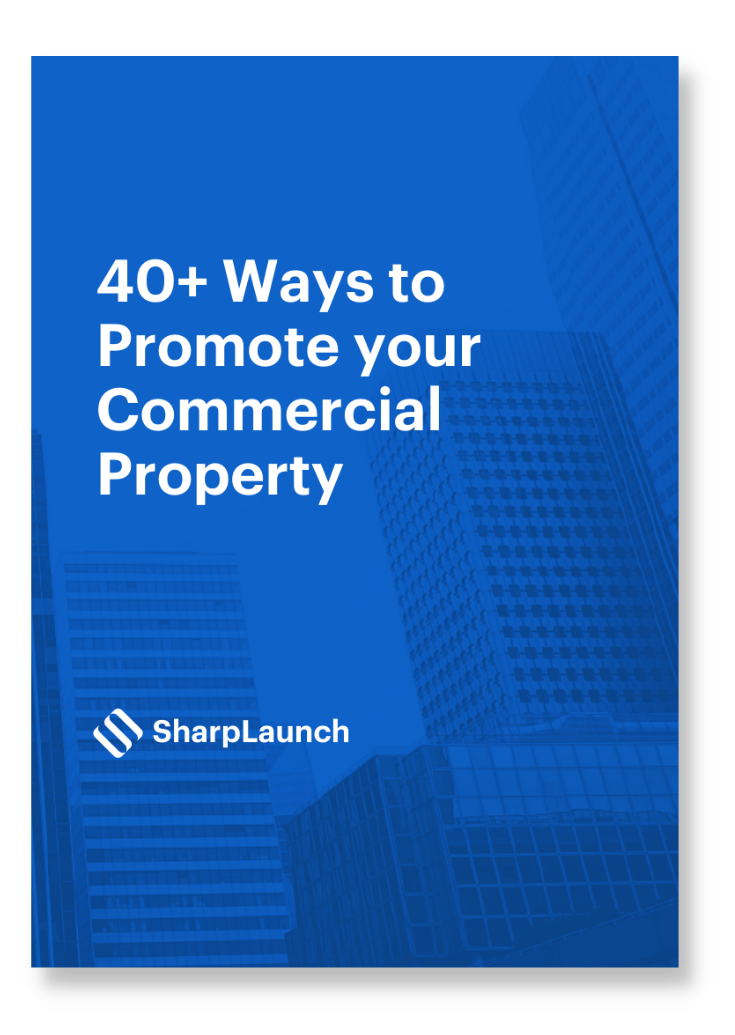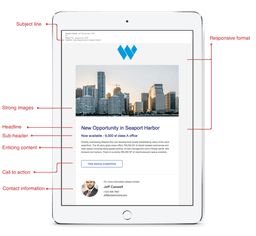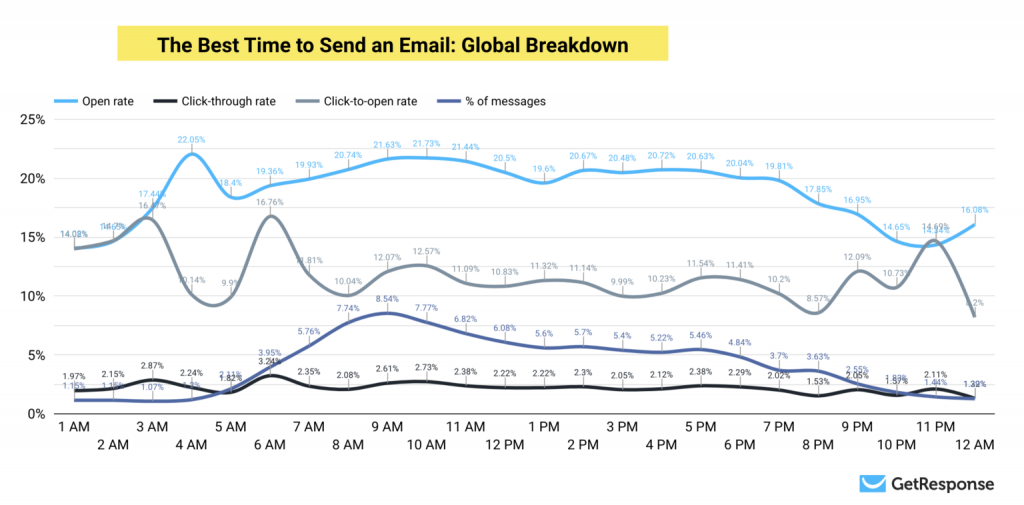
Marketing Best Practices
Commercial Real Estate Email Marketing: The Advanced Guide
Why do some commercial real estate email marketing campaigns succeed while others fall flat?
It can seem like email marketing is a hit-or-miss mystery, but there is a tried-and-true way to harness this powerful tool: you must constantly recalibrate your campaigns and always personalize your messages with a human touch for optimum results.
As technology enables great advances in the commercial real estate industry, every email campaign must be adapted and innovated to meet the moment.
Drawing on this intelligence, email campaigns can be thoughtfully and strategically developed by utilizing smart subject lines, send times and specially designed commercial real estate email templates.
Sounds like a tall order? Worry not. In this comprehensive guide to commercial real estate email marketing, we’ve compiled all the top commercial real estate email marketing tactics you need to create and implement a successful campaign from start to finish.
1. Define Your Audience
Email is a powerful tool that can re-engage lapsed contacts, build relationships with new prospects, and get a deal within feet of the finish line before a sales conversation. All of these benefits, however, are dependent on your understanding of your audience.
Broad, generic messaging broadcast out to a massive list of diverse contacts won’t work, so it’s vital you take the time to better understand who you’re contacting and what they need.
How do you define your audience? Here are some questions you should be able to answer:
- The Demographics – Step one is the basics. What kind of job titles, seniority, age, and general characteristics do your target prospects share? Nothing is universal but try to get a snapshot of what the group looks like.
- What Are Their Problems? – What issues, concerns, or questions do these individuals share? Are they focused on location? Price? Condition? Are there other factors that come up frequently in sales conversations? Know these questions and your emails will better reflect your business to the target audience.
- Where Do They Get Answers? – Where do these people go online to get answers to those questions and solutions to those problems? Get a sense of the commercial real estate websites they use, social media platforms they are members of, and blogs they read.
By knowing the three things above, you can paint a more detailed portrait of your ideal prospect, and your emails will be much better for it.
2. Segment Your Contacts
Broad, generic messages that are broadcast out to a massive list of diverse contacts doesn’t work anymore, so it’s vital you take the time to better understand who you’re contacting and what their interests are.
Segmenting your contact list is by far one of the most powerful things you can do.
Unfortunately, it can also be the most difficult and time consuming. Done right, however, segmentation of your contact list can help you to pinpoint key targets within segments of your list with messages that resonate.
Your giant one-size-fits-all email list could have hundreds or even thousands of prospects who all have specific needs that are unique to their situation. Sending every one of them an update about specific properties doesn’t work as well as segmenting and sending targeted messages.
To segment your list effectively, break it up by specific categories including:
- Location
- Organization Type
- Job Function
- Interest Level
- Target Property
A good list might look like “Retail Buyers – Warm Prospects – Boston”.
The naming conventions can vary depending on your system and how you like to organize things, but the key here is breaking things up to be easily searchable and super targeted.
The goal of list segmentation is to adapt content and messaging to match each segment. Prospects in Boston and Washington DC deal with different issues on a daily basis and will respond to different messages in your emails. The same is true of people in different types of organizations, job functions, and levels of seniority.
3. Manage Your List
A good email list is not necessarily large – it is targeted, primed, and maintained.
It’s better to have 500 contacts who have opened your emails, engaged with your content, and actively sought out your expertise than a list of 5,000 contacts who have never heard of you, or who haven’t opened an email in more than a year.
To maximize return on your emails, keep your delivery rates high, and ensure you know exactly what to expect when you reach out to your list, list management is vital. Here’s what it entails:
- Clean Your Lists Regularly – When an email address changes, your messages will bounce. Those emails often remain in the database for months or even years past the point at which they can be reached. Remove them when you spot a bounce.
- Purge Unsubscribes – If someone unsubscribes, remove them from your email list. As spam and privacy laws tighten, it’s more important than ever to clear these people out and not attempt to contact them.
- Remove Inactive Contacts– No contact is ever truly gone, but there are certain thresholds you can watch. If someone hasn’t opened an email or engaged with your content in more than 12 months, consider removing them, or setting up a cold-nurture campaign to attempt reengagement one last time before deletion.
4. Elements of a Great Email
An effective commercial real estate email template for your property marketing efforts should contain the most important elements that help create impact, quick to digest and drive your prospective tenants or investors to take action.
Subject Line
The subject line is the first impression you make with prospects and the initial call to action delivered to subscribers when trying to improve open rates.
Strong Images
Visuals are hugely important to driving engagement with any content online, especially for property listings blasts. A strong lead image at the top of your newsletter will capture attention and drive readership down the screen.
Headline
Your headline will make it immediately clear what your email is about, like for example, recent property listings, tips about the local market, general information about a building or a specific location.
Sub-header
Sub-headers in an email break up content and keep it from being overwhelming. If you plan on including several property listings, multiple articles, and calls to action, it should be broken up for easy scanning, especially on a mobile device on which there will be a lot of scrolling.
Enticing Content
Your copy needs to be more than just a summary of the property, but a highlight of specific benefits that property has to offer.
Drive traffic to your property listings with enticing copy that offers a reason for someone to click. Keep it short and concise with a clear purpose and you’ll drive much greater engagement out of inboxes.
Call to Action
Include a call to action button or link that stands out from the copy and directs potential tenants and investors to act. Buttons perform better than text links in visual emails while factors like size, design, and color can all attract more attention and get the click throughs to your property websites you’re looking for.
Contact Information
Make it easy for your contacts to get in touch by provide a name, title, phone number and email.
Also, include headshots wherever possible to provide a personal touch to your communications.
5. The Perfect Subject Line
Whether you want to make a good first impression with a new prospect or encourage a long-term client to re-engage, your email need enticing commercial real estate subject lines that stand out in crowded inboxes, pique interest, encourage the recipient to open, and prime them to take the desired action.
By reviewing the open and click rates of your recent campaigns, you can get a better idea of which subject line approaches work best for different segments of your audience and different types of CRE emails. However, there are also several other best practices that can boost the odds of your emails being seen and opened.
Be Specific, Relevant, and Detailed
While brevity is recommended, particularly for mobile-optimized campaigns, it is also important to include concrete, specific details that will communicate exactly why your CRE email is of interest or benefit to the reader:
- Size – When sending property-specific emails, including the square footage in the subject line can immediately appeal to recipients looking for spaces around that size. Pair this approach with a targeted list to enhance its effectiveness. One caveat: Don’t lead with the numbers as this dry intro might turn readers off.
- Location/Area – If the property is in a particularly hot area or one that doesn’t often have spaces available, including that in the subject line can convey the sense of an unmissable opportunity.
- Interest/Competition – By indicating scarcity (e.g. “X spaces left”) or high levels of interest (e.g. “X leases signed just today”), you can create a feeling of urgency to drive engagement.
- Progress/Updates – Mentioning exciting new renderings, before and after shots, or visual progress updates can be highly engaging and build anticipation. This is particularly useful if you have a targeted list of prospects who have shown interest in a property undergoing renovations or a new property being built from the ground up.
Shorten Your Subject Line
Another common factor that directly impacts open rates is subject length.
Specifically, subject lines with 1-3 words perform better than shorter, succinct headlines.
Why? There are a couple of reasons.
First, shorter usually means more personal. When was the last time you wrote a 7-word subject line in capital case to your mother? You probably wrote something like “checking in” or “pictures of kids”. This is how people communicate and it’s the type of emails people respond to.
Source: Yesware
Another factor here is the mobile component.
People read 40% of their email on a mobile device first, and most mobile devices can only display 4-7 words of the subject line.
Go too long and it’s not clear what an email is about. A surefire way to get dumped in the trash.

Source Marketo
6. When to Send Your Emails
There are several bits of “common knowledge” when it comes to email send times. After all, if you can get your email in front of prospects at the right time, they are going to be less busy and more likely to open.
But how do you know when the best time is when there are so many conflicting bits of advice out there?
Here are two things to consider when evaluating the send time for your email:
Avoid the competition
Conventional wisdom says that business emails should be sent between 9am-6pm Tuesday-Thursday.
Avoid Mondays when people are overwhelmed and Fridays when people are checked out. But in reality, because everyone does this, the vast majority of business emails are delivered between 11am-4pm on Tuesday, Wednesday and Thursday. That’s a lot of volume in the middle of the week.
Interestingly, a recent GetResponse study on global data suggests that the best time for sending emails was between 4 am and 6 am (based on the open and the click-through rate).
However, always consider what you would like your recipients to do upon opening the email. If you would like them to take a specific action such as get in touch by phone or email, the best bet would always be to send emails between 8am and 5pm.
The same study suggests that there’s no major difference globally in open and click through rates between workdays, whereas during the weekend those rates decrease.
For US and Canada based audiences, Fridays have the best open rate and in terms of clicks Thursday and Tuesday lead the pack.
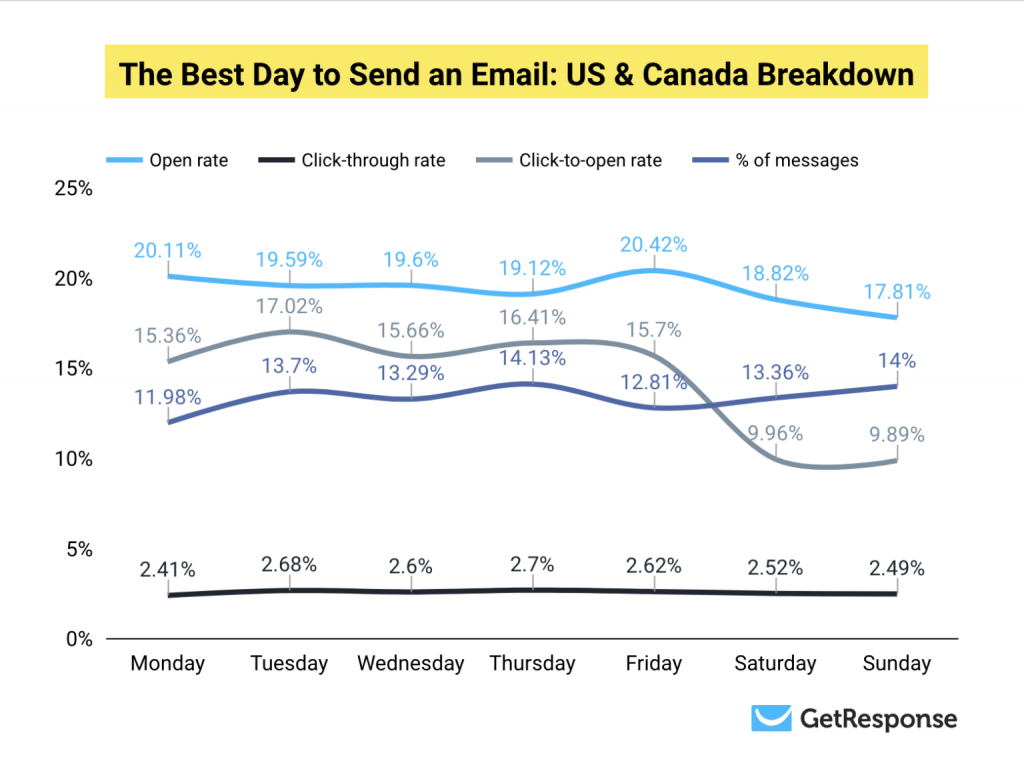
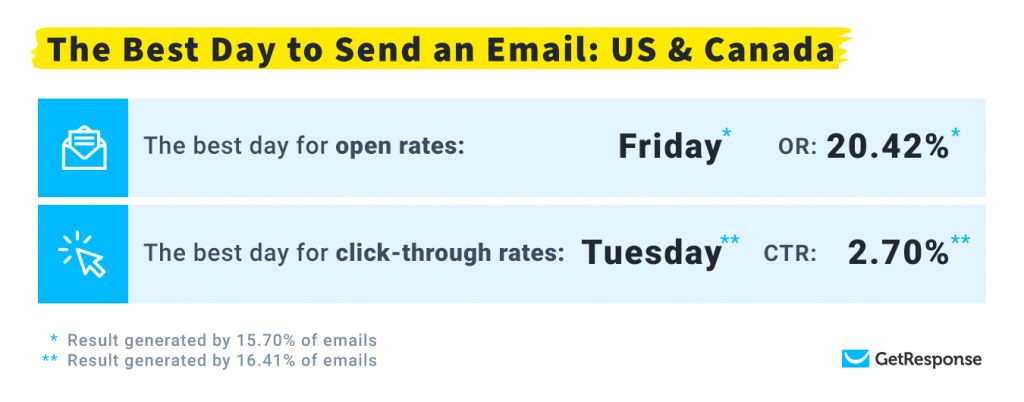
Source Get Response
7. Improve Deliverability
Nothing is more frustrating than preparing an email, finely tuning it for your audience and then seeing that a high percentage of people didn’t even receive it.
There are plenty of things you can do to ensure your emails get where they belong, including some simple, non-technical steps you can take right now to reduce the likelihood they are seen as spam and boost the number that get into the right inboxes.
Check your Sender Score
Did you know every email you send can be seen and tracked by ISPs to ensure you don’t represent a high spam threat level? This is a good thing, though, because it means we can see that data.
Sender Score offers a tool that will share with you your performance when sending emails and then provide a score from 1 to 100. Some of the stuff they use to calculate this score includes:
- Blacklists
- Recent complaints
- Infrastructure (how your emails are sent)
- Message filtering levels
- Sender rejection notices
- Spam traps
- Unknown users
While some of this can represent technical issues you’ll need outside help to address, checking your Sender Score can ensure you are aware of the issues and do your best to address them.
Improving Your Deliverability Rates with Smart Send Strategies
There are several things you can do to improve sender ratings and deliverability based on when you send emails, who you send them to, and how those emails are validated. Some of the simple things you can do right now to address these issues include:
- Sending Consistently – When emails go out in erratic spikes, you might see higher rates of rejection and a lower overall sender score. Sending consistently over time is an important way to avoid this.
- Use the Same Sender – Make sure to keep the sender name consistent for your email. If your sender name switches all the time, you will increase the possibility of getting flagged by spam filters and make it less likely that your emails will be delivered.
- Ensure Your Contacts Are Opted In – The last thing you want is for someone to flag your email as spam. If someone isn’t sure why they’re getting an email from you, that’s a bad sign as it can quickly lead to high spam rates and eventual blacklisting. Only send to people who have requested information from you, and use a double opt-in and email confirmation process to avoid this issue.
- Clean Your List Regularly – On a regular basis, remove bounced emails, unsubscribes, and other non-deliverables from your list. When you send to these and they bounce back, it can trigger a block or filters on your emails to all addresses. Use an email validation service that will check for inactive accounts as well as duplicates, old domains, records that have requested no messages, honeypots designed to catch spam bots, and other issues that could hurt future deliverability rates.
For a commercial real estate marketing campaign, email is one of the most effective tools at your disposal. Which is why it’s so dangerous to send emails that might spike your spam rate or put you on a blacklist that drops your deliverability rates. Be mindful, carefully prune your list and send smartly to avoid this happening.
8. Develop a Follow Up Strategy
If nothing else, remember that follow up wins deals. Even the most robust and effective email marketing campaigns can be run aground by a lack of follow up.
The average email is opened within a day of sending it 91% of the time. That means only 9% of emails opened are opened after a full day has passed. They get buried in unmanaged inboxes and never seen again.
And while it’s easy to assume these lost emails are intentionally ignored, the simple truth is that the average business user receives between 100-150 emails per day.
If something isn’t deemed important during a particularly busy period of time, it will fall into the abyss quickly. So a strong follow up strategy is a must when prospecting via email.
Yesware has a recent study that shows that more than half of first replies only came after the 3rd email was sent, and more than 30% weren’t seen until the 7th email or more.
It can take several follow ups over the course of several weeks to get a response. Don’t give up so easily.
Some other things you should do to improve your follow up game include:
Using email sequences for outreach automation
When contacting cold prospects or those you haven’t spoken with for some time, automation can ensure better follow up over the long term with scheduled sequences. Those that can be updated based on engagement are even better, escalating prospects that open or click an email vs those that do not.
Vary your outreach times
All the best practices in the world mean nothing if your target doesn’t open the email at the time targeted. Vary your outreach time if you don’t get responses during normal business hours or weekdays. Move to weekends, late nights, or off hours to see if there’s a gap in their schedule that makes response more likely.
Resend to non-openers
If someone doesn’t open your email, it doesn’t necessarily mean they are not interested. They could be out of the office, didn’t see the email, or were too busy to read or reply when it was sent. Most people don’t empty their inboxes, so once it’s missed, it’s unlikely to be seen again. To counter this, resend emails to non-openers a week later with a new subject line.
9. Track Results
Finally, for your email efforts to be effective, you need create a real estate marketing report to know what works and what doesn’t.
A surprisingly large number of CRE professionals rely on that gut feeling of business being better or worse to determine if their efforts are actually working.
But it’s important to know not only what works but why it works, when it works, and what changes had the greatest positive impact.
Specifically, you should:
- Track key metrics for your emails – For each of your email sends, you should know the open rate, reply rate, and click rate on any links included in your message.
- Segment based on email type – The data for personal emails sent from your CRM will be different from marketing emails and newsletters sent via autoresponder or marketing tools. Measure each separately to make smarter decisions based on that data.
- A/B test your headlines – For emails going to larger audiences, don’t be afraid to test different types of subject line. If you are contacting several hundred prospects at once via autoresponder, try a handful of different headlines to see which perform best. Software that supports A/B testing in a single batch is even more effective because you can keep all variables static except for the subject line.
- Measure change over time – Track how your metrics change over time based on the changes you make to your campaigns. If you implement a new template, how does this impact your response rates? A pretty new template that drops your open rate by 15% probably isn’t worth the visual upgrade, for example.
10. Pro Tips
★ Use the CC Field to Improve Response Rate
An effective trick that works well for prospecting is to send your emails to multiple people.
Specifically, by sending the email to one person directly and another via CC, you can improve your open and reply rates by as much as 12%.
That’s a big boost and generally improves your likelihood of someone in the organization you’re trying to reach getting the message you’ve sent.
When speaking with prospects, always ask if there is anyone else that should be included in the email. This will help in the long term.
★ Send Targeted Follow up Messages
Good follow up messages are absolutely key to ensure success of your campaigns. Remember the following principles in your next follow-up emails:
- Mention previous discussion and include context to clearly explain what you are referring to
- Make it personal and avoid cliché and generic phrases like “just wanted to check in”, show people you actually care
- Keep it simple – remind them about who you are and why you matter to them
★ A/B Test Actively to Know What Works
Even if you land on a formula that works effectively and drives good open and click rates, it could be better.
And you’ll never know what would or could work better unless you split test. By running the same email with a slight change to different segments of your list you can see what types of language resonate most effectively with your audience. Here are three things you can test doing this:
- Statements vs. Questions in Your Subject Lines – You’ll see data from both sides on whether a question or statement works best. In reality, it’s all about your audience and what they find most engaging. Test your messages with simple tweaks to the format.
- Timing of Your Messages – While there is a benefit to be had to sending emails in off hours, such as the weekend, you should always test to be sure. Make sure it actually works as intended by testing against a more common time or day.
- Personalization – Test several different formats of personalization in your emails. Specifically, you should test use of merge fields in your subject line, salutation, and the call to action at the end of the body of your email.
Conclusion
Email Marketing Done Right is Immensely Powerful
A well-constructed email marketing campaign that pays close attention to the most effective strategies for getting prospects to open, reply to, or click on links in your emails will almost certainly have a positive impact on your business.
The more prospects you can engage with a simple email, the more robust your pipeline will be and the more active your sales reps will be engaging with those prospects.
And it all starts with understanding what works and what doesn’t and making smart changes to improve your results.
Related Blog Posts
Marketing Best Practices
Driving Innovation and Technology Adoption in Commercial Real Estate
In the realm of commercial real estate, the integration of innovation and technology is not...
Company updates
SharpLaunch Announces New Partnership with BuildingEngines
BuildingEngines, renowned for its industry-leading building operations platform Prism, has...
Marketing Best Practices
Marketing Toolkit for Real Estate Investment Sales
Building a healthy pipeline. Attracting the right investors. In commercial real estate...

